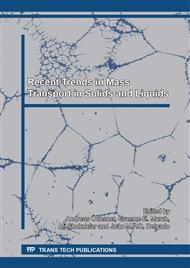p.12
p.29
p.35
p.39
p.48
p.55
p.60
p.66
p.72
Transient Liquid Diffusion Bonding of AISI304 Stainless Steel with a Nickel Base Interlayer
Abstract:
AISI304 stainless steel was bonded by a nickel base interlayer, using a TLP bonding method at 1150 °C with different holding times. The microstructure of the joint region was studied by optical and scanning electron microscopes. The results showed that 20 minutes holding time is sufficient for complete isothermal solidification. At the bonding times of 4, 10, 15 minutes, a eutectic structure was formed at the joint region. The distribution of alloying elements within the joint region and diffusion affected zone were detected using EDS. The results showed that the eutectic microstructure consists of Fe and Cr borides and the isothermal solidified zone consists of solid solution of Fe and Ni at the bonding temperature. Samples with complete isothermal solidified joint were homogenized at 950°C for different times from 30 to 360 minutes to study the distribution of alloying elements between joint region and parent alloy. The results showed more uniform distribution of alloying elements with increasing the homogenization time due to the diffusion of alloying elements between the joint region and the parent alloys. Microhardness and shear strength of joined samples were measured and compared to that of the parent alloy at the same heat treatment condition. The joint shear strength of TLP bonded samples was about 82% that of the parent alloy at the homogenization time of 180 minutes.
Info:
Periodical:
Pages:
48-54
Citation:
Online since:
November 2017
Authors:
Price:
Сopyright:
© 2017 Trans Tech Publications Ltd. All Rights Reserved
Share:
Citation:


